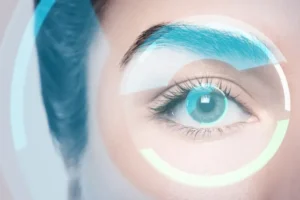Whether you’ve already had LASIK or are still considering it, one big question might be on your mind—Is LASIK permanent, or can the number return after surgery?
The thought of going back to glasses after LASIK can be worrying, but here’s the truth: LASIK provides long-term vision correction, but like natural eyes, it can be affected by age and minor changes over time. So, does that mean your specs might come back? Not necessarily. In this blog, we’ll break down:
- How long LASIK results last
- Why some people experience a slight number regression
- What to do if your vision changes after LASIK
By the end, you’ll clearly understand what to expect after LASIK and how to maintain perfect vision for as long as possible. Let’s dive in!
Contents
Is LASIK Vision Correction Permanent?
 Yes, LASIK is designed to be a permanent solution for correcting refractive errors like myopia (nearsightedness), hyperopia (farsightedness), and astigmatism. The procedure reshapes the cornea to adjust how light enters the eye, effectively eliminating the need for glasses or contact lenses.
Yes, LASIK is designed to be a permanent solution for correcting refractive errors like myopia (nearsightedness), hyperopia (farsightedness), and astigmatism. The procedure reshapes the cornea to adjust how light enters the eye, effectively eliminating the need for glasses or contact lenses.
How Long Does LASIK Last?
- Once LASIK is performed, your cornea remains reshaped permanently.
- Your eyes function just like normal eyes, meaning they can still go through natural aging changes over time.
- For most people, LASIK results last a lifetime unless affected by age-related changes or minor healing regressions.
The Latest Advancements: Making LASIK Safer & More Long-Lasting
With 2025’s cutting-edge technologies, LASIK has evolved into an even safer, more precise, and long-term solution for vision correction. The latest innovations include:
- Contoura Vision – A topography-guided LASIK that corrects corneal irregularities for ultra-sharp vision.
- Wavelight Plus Innoveyes – AI-powered LASIK with 7D eye tracking for enhanced precision.
- SILK Elita – The next-gen bladeless, flapless, ultra-smooth vision correction technology.
These advanced LASIK procedures come with no cuts, no blades, no stitches, and faster healing times, making them the safest and most effective long-term solution for specs removal.
Can Your Eye Number Return After LASIK?
One of the most common concerns people have after LASIK is whether their eye power can return. The good news? For most people, LASIK provides long-lasting vision correction. However, in some cases, minor changes in vision can occur over time due to natural aging or the body’s healing response.
Age-Related Vision Changes (Presbyopia)
- Around the age of 45-50, most people develop presbyopia, a natural age-related condition that affects near vision.
- This happens to everyone, regardless of whether they have had LASIK or not.
- Solution: If needed, options like:
✅ Reading glasses for near vision
✅ Monovision LASIK, where one eye is corrected for distance vision and the other for near vision, can be considered.
Minor Number Regression Due to Healing Response
- In some cases, after LASIK, the eye’s natural healing process may cause a very slight number to return (typically 0.50 to 0.75 D).
- This is a minor issue and does not always require glasses.
- Solution: If the slight number affects vision, a simple LASIK enhancement (laser polishing) can refine the correction and restore clear eyesight.
Should You Be Worried About These Changes?
No, these changes are not a sign of LASIK failure.
✔ Your vision will still be significantly better than before LASIK.
✔ If necessary, small corrections can be made to maintain sharp vision.
LASIK remains one of the safest and most long-term solutions for specs removal, and with modern enhancements like Contoura Vision, Wavelight Plus, and SILK Elita, the chances of regression are even lower.
What To Do If Your Number Comes Back After LASIK?
 If you notice slight changes in your vision after LASIK, there’s no need to panic. In most cases, these changes are minor and manageable. Here’s what you should do:
If you notice slight changes in your vision after LASIK, there’s no need to panic. In most cases, these changes are minor and manageable. Here’s what you should do:
Step 1: Get a Follow-Up Eye Check-Up
- Schedule a visit with your LASIK surgeon or eye specialist.
- They will assess the changes in your prescription and determine if any further treatment is needed.
Step 2: Determine If Glasses Are Necessary
- If the change is small (0.50 to 0.75 D), glasses might not be required for daily activities.
- Many people can still see clearly for most tasks without needing correction.
Step 3: Consider a LASIK Enhancement (Touch-Up Procedure)
- If the number has noticeably returned and affects vision clarity, a LASIK enhancement (laser polishing) can be done.
- This is a quick and safe touch-up procedure that restores vision to perfect clarity again.
Final Thoughts: Can You Prevent This?
✔ Follow your post-LASIK care guidelines carefully to minimize the chances of regression.
✔ Get regular eye check-ups to monitor any changes early.
✔ If changes occur, consult your doctor early to discuss possible solutions like enhancements or alternative treatments.
Conclusion
LASIK is a proven, safe, and highly effective solution for permanent vision correction. With advanced technologies, LASIK today offers unmatched precision, faster recovery, and long-lasting results.
If you’re considering getting rid of glasses for good, there’s no reason to hesitate—LASIK is your gateway to a clearer, sharper, and hassle-free vision. Even if minor changes occur over time, they can be easily managed with follow-ups or enhancements.
Are you looking for LASIK? Experience the freedom of clear vision with advanced LASIK treatment at EyeMantra!
Book your free appointment now at +91 9711116605!



